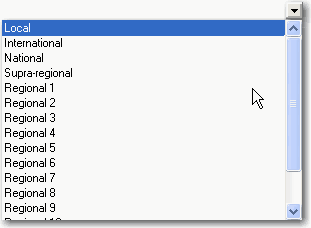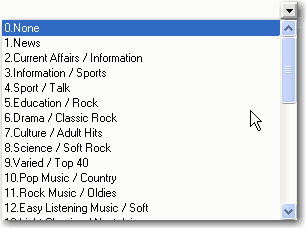
The Radio Data System (RDS) is intended for application to VHF/FM sound broadcasts in the range 87.5 MHz to 108.0 MHz which may carry either stereophonic (pilot-tone system) or monophonic programs. The main objectives of RDS are to enable improved functionality for FM receivers and to make them more user-friendly by using features such as Program Identification, Program Service name display and where applicable, automatic tuning for portable and car radios, in particular.
The Radio Data System has spawned in Europe around 1980. At present it starts to be used in all the world. It brings some useful possibilities. The listerner's receiver can display station name, stations phone number and address, artist and title of actual song playing, traffic announcement, program type and much more.
Range: 0000000000000000 to 1111111111111111
Default: 1000000000000001
Set the 16 bits PI (Programme Identification) Code Value.
If your station has only one frequency, fill your FM frequency to AF and make sure the second digit in PI is 0 (zero).
Range: 0 to 15
Default: 8
Set the Country Code of the PI Code.

Choices: Local | International | National | Supra-regional | Regional 1....Regional 12
Default: Local
Set the Coverage Area Type of the PI Code.
Range: 0 to 255
Default: 1
Set the Programme Reference Number of the PI Code.
In each country, these codes should be systematically assigned and generically linked to the programme families.
Choice: On | Off
Default: Off
Set the Traffic Programme Identification (TP) of RDS.
This is a flag to indicate that the tuned program carries traffic announcements. The TP flag must only be set on programs which dynamically switch on the TA identification during traffic announcements. The signal shall be taken into account during automatic search tuning, so I recommend to turn this flag on even though you don't transmit any traffic announcements.

Choice: 1.News | 2.Current Affairs / Information | 3.Information / Sports | 4.Sport / Talk | 5.Education / Rock\ | 6.Drama / Classic Rock | 7.Culture / Adult Hits | 8.Science / Soft Rock | 9.Varied / Top 40 | 10.Pop Music / Country | 11.Rock Music / Oldies | 12.Easy Listening Music / Soft | 13.Light Classics / Nostalgia | 14.Serious Classics / Jazz | 15.Other music / Classical | 16.Weather / Rhythm and Blues | 17.Finance / Soft Rhythm and Blues | 18.Children's Programmes / Language | 19.Social Affairs / Religious Music | 20.Religion / Religious Talk | 21.Phone In / Personality | 22.Travel / Public | 23.Leisure / College | 24.Jazz Music / Unassigned | 25.Country Music / Unassigned | 26.National Music / Unassigned | 27.Oldies Music / Unassigned | 28.Folk Music / Unassigned | 29.Documentary / Weather | 30.Alarm Test / Emergency Test | 31.Alarm / Emergency
Default: 1.News
Set the Programme Type (PTY) of RDS.
Program type (PTY) is an identification number to be transmitted with each program item and which is intended to specify the current Program type within 31 possibilities. This code could be used for search tuning. The code will, moreover, enable suitable receivers and recorders to be pre-set to respond only to program items of the desired type. The last number, i.e. 31, is reserved for an alarm identification which is intended to switch on the audio signal when a receiver is operated in a waiting reception mode.